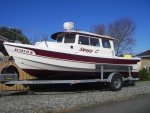If you are changing the tires on the ground because they are old, just remember the spare is just as old even though it has not been on the ground (have you checked the air in your spare). The spare may be considered "just the get home tire", but consider that you may be in the middle of the hot desert (that is what caused your old tire to blow in the first place) and you have 100 miles or more to get home. If you blow an old tire because it is old and it cannot be repaired, then you probably will not be able to find an exact replacement (brand, model, size). All the tires on a trailer, including the spare, should be the same brand, model, and size. Never mix bias and radial - could have big trouble. A load range is a load range, regardless of the type of tire (radial or bias). The load range of the tire should match the load range of the axle, which should match the load range of the trailer.
If the tires you have are the original tires for your trailer, and the boat on your trailer is not overloading the trailer, then the load range for the tire is probably sufficient. You can increase the load range if you want, but you may get a little extra bounce if you have a light load.
If your trailer was made for a single axle, you may not have the room to add another axle. I have not seen kits to add an axle to a trailer. That does not mean they do not make them - I just have not seen one. You would usually add an axle to add additional weight (load) to the trailer. There is a lot more to increasing the load on a trailer than adding an axle. The whole structure of the trailer is different, probably need to add brakes, additional lighting, etc. You would be better off buying a tandem trailer, but then the trailer may be a lot longer than your boat. Unless you are overly concerned about safety, then I would recommend staying with the trailer you have. If you really must have the tandem trailer, then you should also consider dually's for your truck. To me, it is not coast effective for the load.


